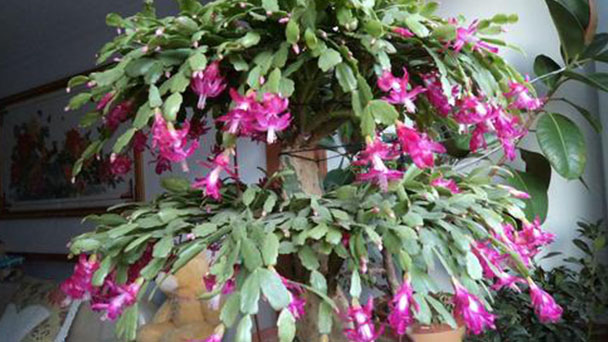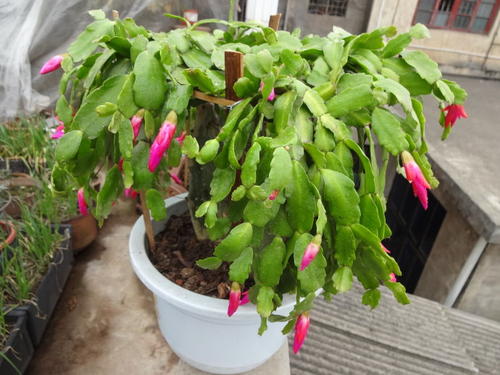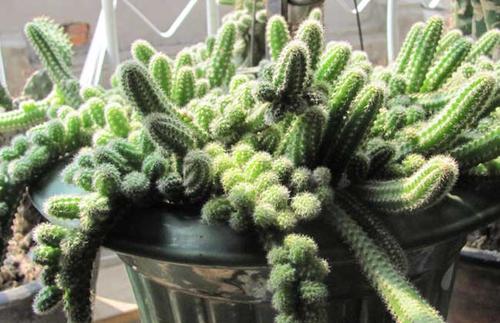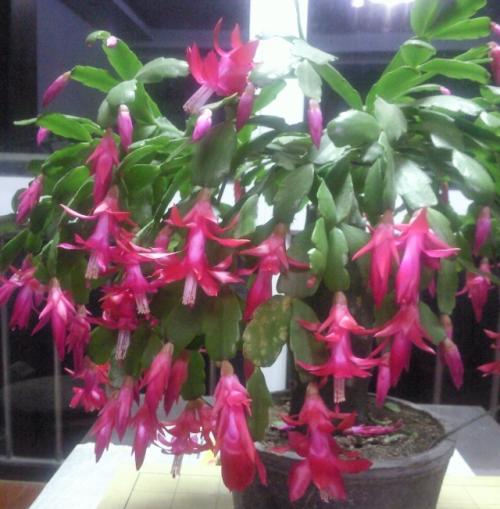Christmas cactus (Schlumbergera) profile
Written by Maggie
Oct 20 2021

Christmas cactus (Schlumbergera) is a cactus. The flat knobs are light green and the flat knobs are light green. Christmas cactus is 3 -- 3.5 cm long and 1.5 -- 2.5 cm wide, with a distinct midvein, margin shallowly undulate. The flowers are neat, about 5 cm long, red. The suitable temperature for Christmas Cactus growth is 15 ~ 25℃;
Christmas cactus is a favorite indoor potted flower. Buy a robust potted plant, can appreciate the flower with flowery color not only, still can regard indoor potted as long-term ornamental and cheerful mood.
Christmas cactus picture
Christmas cactus info
| Botanical Name | Schlumbergera truncata |
| Common Names | Christmas cactus, holiday cactus, crab cactus |
| Plant Type | Cactus |
| Sun | Partial sun |
| Hardiness Zones | 10–12 (USDA) |
| Flower color | Pink, red, purple, orange |
| Native Area | South America |
| Mature size | 6–12 in. tall, 12–24 in. wide |
Morphological features of Christmas cactus
Christmas cactus is native to the tree trunk, with many branches, branches drooping. Branches are flattened, fleshy, segmented, each node oblong, leaflike, 1-2 obtuse teeth on each side, apically truncated. Flowers are solitary branchlike, corolla neat, a variety of colors, including purple, red, white, etc. Cultivated varieties in addition to purple, there are white, orange, light yellow, deep red and other varieties. Pleasant because of appearance and flowers and crab claw orchid very similar, it is easy to be considered as crab claw orchid. Note that Christmas cactus should be distinguished from the crab's paw orchid and the false Epiphyllum.
The ecological habits of Christmas cactus
Christmas Cactus likes a warm and humid climate. The soil should be rich in organic matter and well-drained. Keep the soil moist during the growing season. Apply thin fertilizer every two weeks. The optimum growth temperature is 19 ~ 32℃, and 7 ~ 13℃ in winter. Christmas cactus is slightly shaded tolerant, should be in a half shade environment, summer strong direct sunlight, often dormancy in summer high-temperature performance, then less watering. Christmas cactus is a short-day plant, winter flowers.
How to grow and care for Christmas cactus
The temperature
Christmas Cactus likes warmth. The suitable temperature for its growth is 15-25 ℃, and it is not cold resistant. It is better to overwinter the temperature above 51. The tricorn has a higher requirement for temperature, and the optimal temperature for growth is 25-37 ℃. At 20℃, the growth is slow, and at 15℃, the growth stops. The Christmas cactus is vulnerable to cold damage in winter, which makes the grafted Christmas Cactus plants lose their flowers. Cactus cold resistance is strong, grafting after the best to maintain a temperature of about 101. Also afraid of high temperature, 30℃ above growth retardation and into the half dormant period, should be placed half shade and well-ventilated place.
Light
Christmas cactus likes half shade and avoids strong direct sunlight. Light is too strong, can make the plant become verticillium, stem and leaves dry. Shading should be carried out from May to September, and the rest of the time needs sufficient sunshine. The formation and development of buds require continuous darkness for 12 to 14 hours a day. Flower bud differentiation and pregnant bud, the night can not have too bright light, otherwise it will affect the pregnant bud bloom. Flowering time can be prolonged with proper shade during flowering.
Watering
Christmas cactus is more resistant to drought and water. Spring and autumn growth period should be fully supplied with water, keep the basin soil moist. But should not be watered too much, otherwise easy to lead to miscellany root rot. The potting soil when flowering requires moist and partially dry, watering too much and cause the potting soil to be too wet, will appear bud wither and fall off. After flowering dormant period and summer half dormant period, should pay attention to control watering, and prevent rain, water more or summer by rain will lead to plant rot.
Humidity
When the weather is clear and the air is dry, spray your cactus plants with foliage water often. Summer also to the surrounding environment 'warm air is relatively modest, reduce acid. Fertilizer: does not like large amounts of fertilizer. However, due to a large number of buds and flowering, it needs to consume a large number of nutrients, so it must be given enough nutrients in order to bloom normally.
When the Christmas cactus begins to grow in the spring, a nitrogen-based fertilizer should be applied every 10 days to thicken the emerging leafy stems. In autumn, flower buds began to differentiate, and phosphorus fertilizer should be applied once every 7-10 days to promote flower bud differentiation and bud growth. Insufficient nutrients often cause falling buds and flowers. Fertilizer should be stopped when dormant in winter and semi-dormant in summer during the flowering period.
Trim
Christmas Cactus in spring together with turning over the pot once shear, thinning off the thick branches, and the left branches are shrunk. Cutting off the front end of the centigrade nodular stem can be conducive to the growth of leaves and strengthen the growth of the plant. After showing buds, if there are too many buds, thinning should be carried out. Generally, 1 bud should be left for each leaf stem.
Double basin
Turn over the pot once every 2 years. Turn over the pot should be combined with pruning after flowering to before germination and growth. Pleasant drainage, breathable good fertile soil, matrix available leaf rot soil, peat soil, rice chaff ash and other materials prepared.
How to encourage more blooming
Keep Christmas cactus cool (around 50 degrees) following their blooming period. Water them to keep the soil just barely moist, and be sure to withhold fertilizer. When new growth begins, use the following strategy to encourage blooming: House the plants in an environment with a temperature between 55 and 65 degrees, and alternate between giving them 10 hours of light and 14 hours of total darkness for four to six weeks after the growth appears. When buds appear, introduce the plant to warmer temperatures and begin regular culture, as described above. Plants should bloom in about six weeks.
The propagation of Christmas cactus
Christmas Cactus can be propagated by cuttings or grafting. In the growing season, April to May is the most appropriate, stem node 1 ~ 4 or with branching cutting can be. Cutting when the wound does not touch water, in the sunlight is not direct air for two or three days, makes wound healing, not easy to rot. Root in a cool place before insertion, waterless, and root in about 20 days. Christmas Cactus is easy to root, but the roots are thin and weak, not resistant to water and moisture, and the growth is poor. Therefore, it is often grafted on other cactus plants with strong roots to accelerate the growth. Commonly used anvil no cactus, cactus, cactus, measuring day foot, etc. Cottage or grafting seedling common two years can blossom. In short sunshine (8 to 12 hours of light per day), flowering can occur in 2 to 3 months. Shading is done in early July and the flowers will bloom by late September. Apply a thin organic liquid fertilizer every 2 to 3 weeks during the growing season of Christmas Cactus, as well as a small amount of compound chemical fertilizer. After bud formation, pot soil can not be too dry, too wet, so as to avoid bud fall off.
Cutting propagation
Cutting matrix: it is used for cutting nutrient soil or river sand, clay soil and other materials. Family cuttings limited to the condition is difficult to get the ideal cuttings matrix, the use of this site has been prepared and disinfected cuttings matrix; Medium-coarse river sand is fine, but rinse with clean water several times before use. Sea sand and saline areas of river sand do not used, they are not suitable for the growth of flowers and plants. At noon in early spring or late autumn, the highest temperature is not more than 28 ℃, the lowest night not below 15 ℃) growth season, and cut the leaf or stem (will take 3 ~ 4 leaf), inserted after being wound dry in the matrix, cutting matrix and a little wet, too dry or water damage as long as the matrix, can quickly grow roots and buds. In late spring to early autumn when the temperature is higher, cuttings are extremely decaying, it is best not to cuttings.
Grafting propagation
Most grafting Christmas Cactus is one palm at a time, supported by a round frame. When Christmas Cactus grows for three or four years, it naturally forms many and long stem nodes, dense and deep, with no ventilation and light. This will make its photosynthesis is affected, appear soft and thin stem nodes or fall off, sterile bud blooming and other ills. In order to solve this malpractice, most of them adopt the method of removing the overdense stem node in the inner chamber. Adopting the method of layered arrangement with long stem nodes and climbing up another layer to form two layers, the flower shape is plump and the branches and flowers are flourishing.

Prevention and control of pests and diseases of Christmas cactus
A small number of family cultivation rarely occur pests and diseases. Sometimes it can infect a red spider or scale insect, and in severe cases, it can cause the segments to fall off. Should be in potted flowers into the room before careful inspection, if insect pest, usable insecticide, acaricide prevention and control.
Disease control of Christmas cactus
Rot
It is mainly due to poor drainage ventilation of basin soil, continuous excessive humidity, resulting in the amount of days foot decay. Prevention and control: basin soil drainage water must be better, rainy weather in the ventilated indoor plant, regularly spray 50% carbendazim wettable powder 500 times the liquid sterilization. If local rot is found, it should be immediately cut off with a disinfected knife. Do not drench the wound until it has healed. Christmas Cactus in the prevention of serious rot, that is, do not water, with methyl thiocyanin (also known as methyl tocloth law)70% wettable powder corrosion effect is good. It not only has a strong bactericidal effect, but also has endoinhalability, prevention and cure, and the treatment effect is very good. Keep the wound bare and dry during treatment. Dry the wound the faster the better, do not rush to cover soil, in order to prevent secondary infection. When the disease plant to restore vitality, at least half a month can not water, in order to prevent the disease recurrence. After a few months of maintenance, the wound is sure to heal, to cover the dry sand, after which it will not be long before new roots will sprout.
Soot disease
This disease is accompanied by the harm of powder medium and occurs, the affected parts appear coal-gray disease spots, affect photosynthesis, symmetrical, with more than 10 branches with buds. A few flower buds bloom, most of the budding plants for the first grade. The flowering period of plants with many flowers and few buds will pass, so don't buy those for the purpose of viewing flowers.
Scale insects
Harm leaves, buds, serious cause soot disease. Commonly used pesticides: 25% imithiophos 800-1000 times solution, 50% marathon emulsion 1000 times solution, oxidized dimethoate 1200 times solution, 40% fast culling 1000 times solution.Manual can be removed by toothpick.
Aphids
Damage to young leaves and buds. Commonly used pesticides: 40% diethoate emulsion 1000 times liquid, DDVP 700-800 times liquid.
Christmas cactus uses
The garden use of Christmas cactus
Christmas cactus is usually a potted plant with a long flowering period. It can be displayed or hung in the house. Christmas Cactus is full plant shape, flowers numerous and colorful, and in the Spring Festival before and after the opening, is a rare indoor appreciation of flowers. Christmas Cactus is beautiful in shape and showy in flowers. It can be grown indoors where the sunlight is not enough, and can be used to decorate the study and living room. (Find more best indoor hanging plants here.)
Resistance to radiation
In life and work, planting a pot of Christmas Cactus can absorb electromagnetic radiation. The breathing holes of Christmas Cactus open at night, taking in carbon dioxide and pumping out oxygen. In the home or the office of the electrical appliances beside the plant, can effectively reduce various kinds of electric and electronic products produced by the electromagnetic radiation pollution, make the negative particle concentration in indoor air increases, so, in the home or the office of the electrical appliances beside the plant, can help the human body as far as possible to reduce the computer's radiation. There is also a kind of argument on geomantic, plant of large potted pointed leaf is put on the balcony, can hasten auspicious avoid fierce.
Natural oxygen bar
Christmas cactus breathing takes place in the evening when it is cooler and damp. When you breathe, you inhale carbon dioxide and give off oxygen. So, in the room placed Jinhu such a behemoth, no less than added an air freshener, can purify indoor air. Therefore, it is also the ideal indoor flowers for nighttime decoration.
Dust collection master
Don't underestimate Christmas Cactus, they are still the master of collecting dust! Placing a pot of Christmas Cactus indoors, especially hydroponic Christmas Cactus (because hydroponic Christmas Cactus is cleaner and more environmentally friendly), can play a role in purifying the air. Method: the first planting less water, can not let the sun exposure, after one to two months water, less watering, after watering the water should be timely ventilation to avoid too much water causing root rot.

Latest Updated
- Benefits of Bugleweed - 7 Science-backed Health Benefits
- Bugleweed Dangers & Side Effects - Is It Poisonous?
- How to Plant Evergreen Trees - What You Should Know
- When to Plant Evergreens - Grow Guide for Evergreen Trees
- 12 Wonderful Evergreen Shrubs for Your Garden
- 12 Popular Evergreen Plants with Pictures for Beginners
- When And How To Prune A Lilac Bush Like a Pro
- How to Grow & Care for Lilac Vine (Hardenbergia Violacea)
- Japanese Lilac Tree (Syringa Reticulata) Care & Propagation Guide
- Shumard Oak Pros and Cons - What to Know
Popular Articles
- Winter maintenance of Antirrhinum Majus
- How to Grow Terminalia Mantaly Tree
- How to Grow and Care for Crossostephium Chinense
- How to grow Antirrhinum Majus in spring
- Peristeria Elata (Dove Orchid) Profile: Info & Care Guide
- Underwatered Snake Plant (Sansevieria Trifasciata) - Signs And How To Fix
- How to Care for Brazilian Jasmine Plant (Mandevilla Sanderi)
- How to Grow & Care for Graptopetalum Purple Delight in Summer
- Rosa Chinensis (China Rose): Plant Growing & Care Tips
- How to Care for Baby Sun Rose (Aptenia Cordifolia)
